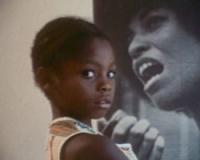Writer, director Charles Burnett’s fourteen minute short The Horse (1973) is a visually romantic and eloquent film. It has been described as a coming-of-age tale though it feels more like a peek into the collision of two worlds. There are two aspects of this film that Burnett mastered; the cinematography and the character of Walter. Visually, the film creates a world bordering on the old and the new. The non-working ranch, dilapidated house and solitary horse stand as vestiges to a world dying before our eyes. The impending death of the horse is the end of this western world. The character of Walter, on the other hand, represents the new world. Burnett shows Walter paying amazing attention to the hemline of his pants and the cleanliness of his city shoes. This moment portrays just how incompatible the two worlds are. Walter’s speech is a halting contrast to the languid sounds of the ranch. His brashness disturbs the stillness and invades the calmness of this fading place. Walter’s disregard for the death of the horse is further telling of a world no longer needed or wanted by the modern one. What begins in daylight, ends in dark, an erudite ending.
—Dawn Spinella






 Mobile Navigation
Mobile Navigation

